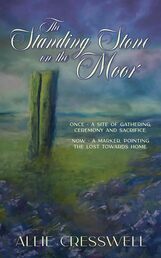CMP#223 Another great tale from Allie Cresswell
 This blog explores social attitudes in Jane Austen's time, discusses her novels, reviews forgotten 18th century novels, and throws
some occasional shade
at the modern academy. The introductory post is here. My "six simple questions for academics" post is here. Spoilers abound in my discussion of these forgotten novels, and I discuss 18th-century attitudes which I do not necessarily endorse. CMP#223 The Standing Stone on the Moor, another engrossing tale from Allie Cresswell
This blog explores social attitudes in Jane Austen's time, discusses her novels, reviews forgotten 18th century novels, and throws
some occasional shade
at the modern academy. The introductory post is here. My "six simple questions for academics" post is here. Spoilers abound in my discussion of these forgotten novels, and I discuss 18th-century attitudes which I do not necessarily endorse. CMP#223 The Standing Stone on the Moor, another engrossing tale from Allie Cresswell
 I just had the pleasure of losing myself in the new release of Allie Cresswell's Talbot family series. Allie Creswell has created another story that pulls you into a different world with her skilful evocation of time and place—in this case, a small village on the Yorkshire moors during the Industrial Revolution, when the labouring classes of England were moving from their isolated farms to crowded tenements and the "dark satanic mills." What I love about Allie's heroine, Beth Harlish, is that she is not as a raving beauty. She's nice-looking, but her qualities of intelligence and character are what make two men fall in love with her. This romantic triangle was so exquisitely balanced that I had no idea who would prevail until the very end.
I just had the pleasure of losing myself in the new release of Allie Cresswell's Talbot family series. Allie Creswell has created another story that pulls you into a different world with her skilful evocation of time and place—in this case, a small village on the Yorkshire moors during the Industrial Revolution, when the labouring classes of England were moving from their isolated farms to crowded tenements and the "dark satanic mills." What I love about Allie's heroine, Beth Harlish, is that she is not as a raving beauty. She's nice-looking, but her qualities of intelligence and character are what make two men fall in love with her. This romantic triangle was so exquisitely balanced that I had no idea who would prevail until the very end. Allie keeps her storylines and all her varied characters in motion and you just want to keep turning the page. It's no easy feat to create so many vivid and distinct characters. It's almost Dickensian.
Another thing I really love about Allie’s historical fiction is her descriptions of every day life. With her skillful touch for the telling detail, you are right there, moving between a desolate group of Irish refugees from the Great Famine, to the dangerous depths of a Yorkshire coal mine, to the cloistered lives of genteel spinsters, to the brash, crude, rising class of the newly-prosperous mercantile class and the impoverished nobility clinging to their rank and privileges. Beth Harlish navigates a society dominated by class barriers and open bigotry. She follows her own convictions of right and wrong, but the most important person in her life—her brother Frank—turns her world upside down.
The Standing Stone on the Moor can be read as a stand-alone novel, but I suspect that after finishing it, you will want to turn to the other books in the Talbot family trilogy.
If you haven't read any Allie Cresswell and you are a Janeite, you will enjoy her Emma prequel, the Highbury Trilogy. I also loved The House on Winter Moss, in which--as with this book--the weather is a character in the novel. The north Yorkshire coast was a hotbed for smugglers bringing in luxury goods like tea and wine to avoid taxation. Smuggling is featured in The Standing Stone in the Moor. Here is an article about the Yorkshire smugglers and their techniques--sort of a smugglers' how-to. Previous post: The wealthy aunt who didn't help her nieces
Published on June 17, 2025 00:00
No comments have been added yet.



